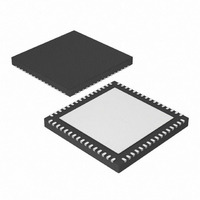PIC24FJ256GB106-I/MR Microchip Technology, PIC24FJ256GB106-I/MR Datasheet - Page 11

PIC24FJ256GB106-I/MR
Manufacturer Part Number
PIC24FJ256GB106-I/MR
Description
IC, 16BIT MCU, PIC24F, 32MHZ, QFN-64
Manufacturer
Microchip Technology
Series
PIC® 24Fr
Datasheets
1.PIC24FJ128GA106-IPT.pdf
(52 pages)
2.PIC24FJ64GB106-IPT.pdf
(16 pages)
3.PIC24FJ64GB106-IPT.pdf
(352 pages)
4.PIC24FJ192GB108-IPT.pdf
(328 pages)
Specifications of PIC24FJ256GB106-I/MR
Controller Family/series
PIC24
No. Of I/o's
51
Ram Memory Size
16KB
Cpu Speed
32MHz
No. Of Timers
5
Core Size
16 Bit
Program Memory Size
256KB
Peripherals
ADC, Comparator, PWM, RTC, Timer
Core Processor
PIC
Speed
32MHz
Connectivity
I²C, SPI, UART/USART, USB OTG
Number Of I /o
51
Program Memory Type
FLASH
Ram Size
16K x 8
Voltage - Supply (vcc/vdd)
2 V ~ 3.6 V
Data Converters
A/D 16x10b
Oscillator Type
Internal
Operating Temperature
-40°C ~ 85°C
Package / Case
64-VFQFN, Exposed Pad
Processor Series
PIC24FJ
Core
PIC
Data Bus Width
16 bit
Data Ram Size
16 KB
Interface Type
I2C, SPI, UART
Maximum Clock Frequency
32 MHz
Number Of Programmable I/os
52
Number Of Timers
5
Maximum Operating Temperature
+ 85 C
Mounting Style
SMD/SMT
3rd Party Development Tools
52713-733, 52714-737, 53276-922, EWDSPIC
Development Tools By Supplier
PG164130, DV164035, DV244005, DV164005, PG164120, DM240001, DM240011
Minimum Operating Temperature
- 40 C
On-chip Adc
10 bit, 16 Channel
Lead Free Status / RoHS Status
Lead free / RoHS Compliant
For Use With
876-1004 - PIC24 BREAKOUT BOARD
Eeprom Size
-
Lead Free Status / Rohs Status
Details
Available stocks
Company
Part Number
Manufacturer
Quantity
Price
Company:
Part Number:
PIC24FJ256GB106-I/MR
Manufacturer:
TI
Quantity:
1 292
3.0
ICSP mode is a special programming protocol that
allows you to read and write to the memory of
PIC24FJXXXGA1/GB1 devices. The ICSP mode is the
most direct method used to program the device; note,
however, that Enhanced ICSP is faster. ICSP mode
also has the ability to read the contents of executive
memory to determine if the programming executive is
present. This capability is accomplished by applying
control codes and instructions, serially to the device,
using pins PGCx and PGDx.
In ICSP mode, the system clock is taken from the
PGCx pin, regardless of the device’s oscillator Config-
uration bits. All instructions are shifted serially into an
internal buffer, then loaded into the Instruction Register
(IR) and executed. No program fetching occurs from
internal memory. Instructions are fed in 24 bits at a
time. PGDx is used to shift data in and PGCx is used
as both the serial shift clock and the CPU execution
clock.
3.1
Figure 3-1 shows the high-level overview of the
programming process. After entering ICSP mode, the
first action is to Chip Erase the device. Next, the code
memory is programmed, followed by the device
Configuration registers. Code memory (including the
Configuration registers) is then verified to ensure that
programming was successful. Then, program the
code-protect Configuration bits, if required.
© 2007 Microchip Technology Inc.
Note:
DEVICE PROGRAMMING – ICSP
Overview of the Programming
Process
During ICSP operation, the operating
frequency of PGCx must not exceed
10 MHz.
PIC24FJXXXGA1/GB1
FIGURE 3-1:
3.2
Upon entry into ICSP mode, the CPU is Idle. Execution
of the CPU is governed by an internal state machine. A
4-bit control code is clocked in using PGCx and PGDx,
and this control code is used to command the CPU (see
Table 3-1).
The SIX control code is used to send instructions to the
CPU for execution, and the REGOUT control code is
used to read data out of the device via the VISI register.
TABLE 3-1:
0000b
0001b
0010b-1111b N/A
Control Code
4-Bit
ICSP Operation
Program Configuration Bits
SIX
REGOUT
Verify Configuration Bits
Mnemonic
CPU CONTROL CODES IN
ICSP™ MODE
Program Memory
Verify Program
Enter ICSP™
Perform Chip
HIGH-LEVEL ICSP™
PROGRAMMING FLOW
Exit ICSP
Erase
Done
Start
Shift in 24-bit instruction
and execute.
Shift out the VISI (0784h)
register.
Reserved.
Description
DS39907A-page 11












